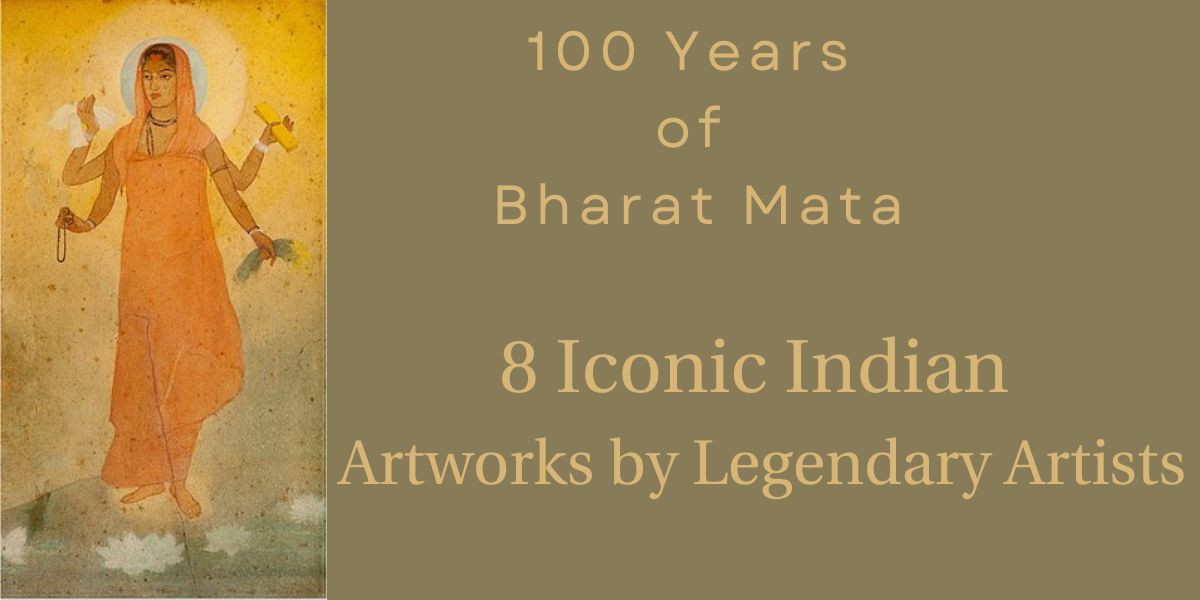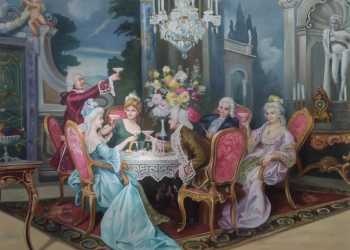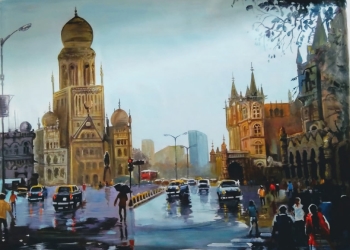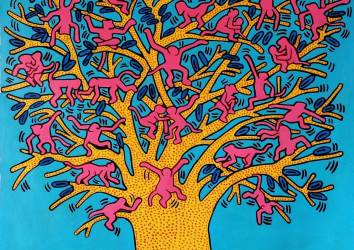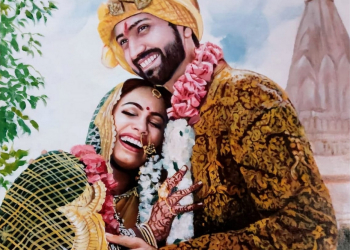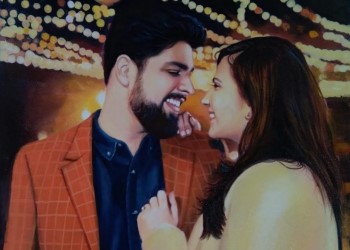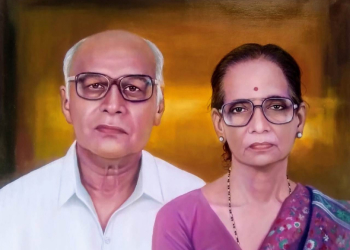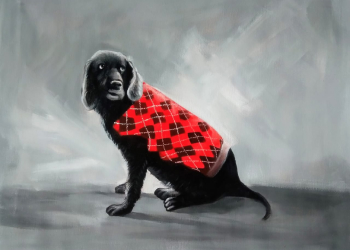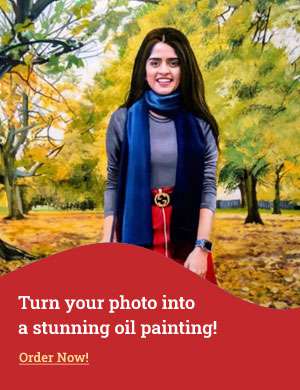100 Years of Bharat Mata: 9 Iconic Indian Artworks by Legendary Artists
In this post, we explore the changing depictions of Bharat Mata by 8 legendary artists over the last century. A unifying symbol of the nurturing Mother, who protects her children, the citizens of the great nation of Bharat.
There has been considerable brouhaha in the media over the supposed renaming of India to Bharat. The debate has drawn unnecessary attention and controversy as Article 1 of the Indian Constitution already uses both "India" and "Bharat" interchangeably, stating, "India, that is Bharat, shall be a Union of States."
But thousands of years before the Indian Constitution adopted the name Bharat & India, as the name for the country, Bharat was already widely used.
One of the earliest mentions of Bharat is in the Vishnu Purana, estimated to be composed between the period 400 CE and 800 CE. The location of Bharata Varsha was geographically defined in Vishnu Purana in the following shloka:
उत्तरं यत्समुद्रस्य हिमाद्रेश्चैव दक्षिणम् ।
वर्षं तद् भारतं नाम भारती यत्र संततिः ।।
Uttaraṃ yatsamudrasya himādreścaiva dakṣiṇam
varṣaṃ tadbhārataṃ nāma bhāratī yatra santatiḥ
This shloka means: “The country (Varsam) that lies north of the ocean and south of the snowy mountains is called Bharatam; there dwell the descendants of Bharata.
While Bharat Desha has existed for thousands of years, Bharat Mata, or the conception of India as a nurturing Mother is more recent. The rise of the modern Westphalian nation-states, a rising tide of Nationalism, and the Swadeshi freedom movement compelled Indian artists, thinkers, and intellectuals to deify their motherland as Bharat Mata. A unifying symbol of the nurturing Mother, who protects her children the citizens of the great nation of Bharat Varsha. In this post, we explore the changing depictions of Bharat Mata by different artists over the last century.
Who is Bharat Mata?
The national personification of India as a mother goddess, known as Bharat Mata (Hindi, derived from Sanskrit), Mother India, or Bharatamba (incorporating 'amba,' meaning mother), emerged as an important symbolic representation in Indian art and literature. She is iconographically depicted as a woman draped in a saffron sari, often bearing the Indian national flag and sometimes accompanied by a lion. As an allegorical figure, Bharat Mata embodies the cultural, spiritual, and political unity of the nation, representing India and its populace as a nurturing maternal force. Her embodiment serves to promote sentiments of national cohesion and pride, transcending religious, caste, or linguistic differences. The common portrayal of Bharat Mata bearing national symbols such as the flag and map of India underscores her status as the unifying national personification of the country and its citizenry. Through this evocative imagery, artists have highlighted Bharat Mata's role as the symbolic mother figure and embodiment of the Indian nation.
Painting of Bharat Mata By Abanindranath Tagore
One of the first artists to imagine India/ Bharat as the Mother was the renowned artist and founder of Bengal School of Art Abanindranath Tagore (1871-1951). One of his greatest most loved creations and critically acclaimed paintings is Bharat Mata.
Painted by Abanindranath Tagore in 1905, Bharat Mata was personified as a divine Bengali woman Sadhvi (saint) holding four symbolic objects in the conventional manner of of Hindu diety. The objects were emblems of nationalist aspirations towards economic and cultural self-sufficiency and Independence. Anna (sheaves of paddy, symbolizing food), Vastra (a piece of white fabric symbolizing clothing), Skisha ( the Vedas symbolizing learning & knowledge), and Diksha (rosary beads symbolizing spiritual knowledge).
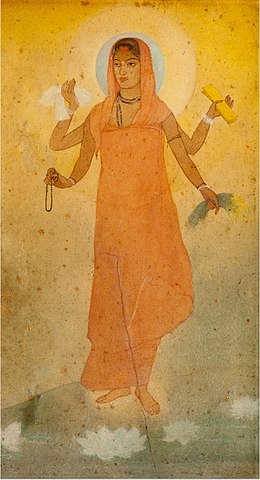 Bharat Mata painting by Abanindranath Tagore 1905 (Image Source: Wikipedia Commons)
Bharat Mata painting by Abanindranath Tagore 1905 (Image Source: Wikipedia Commons)
Title: Bharatmata
Creator: Abanindranath Tagore
Date: 1905
Type: Watercolour
Physical Dimensions: 10.5 inches x 6 inches (26.67 cm x15.24 cm)
Location: Victoria Memorial Hall, Kolkata, India
Handmade Art Reproductions & Landscape Paintings
Initially, Abanindranth Tagore named the painting, Banga Mata (Mother Bengal), however, it was Sister Nivedita, who saw the potential of the painting to become a symbol for the nationalist forces and connect with the masses as the personification of India and renamed it to Bharat Mata.
The Bharat Mata painting was first published captioned Matri Murti in Prabasi, a Bengali literary magazine. Sister Nivedita, who made her debut as a critic, introduced the patriotic painting in Prabasi. She wrote: "We have here a picture which bids fair to prove the beginnings of a new age in Indian art. Using all the added means of expression that the modern period had bestowed upon him, the artist has here given expression nevertheless to a purely Indian idea, in Indian form. The curving line of the lotuses and the white radiance of the halo are beautiful additions to the Asiatically conceived figure with its four arms. This is the first masterpiece, in which the Indian artist has actually succeeded in disengaging, as it were the spirit of the motherland...If nationality and civic ideal..are to be the distinguishing marks of the new era, then it is clear that we must have definite symbols under which to think of them." Later she announced," I would reprint it if I could by tens and thousands and scatter it broadcast over the land, till there is not a peasant's cottage nor a craftsman hut that had not the presentment of Bharat Mata somewhere on its walls."
The painting was conceived by Abanindranath Tagore as a reaction to the political turmoil back in the day of the British Imperial rule in Bengal. The then Viceroy of India, Lord Curzon decided to partition the state of Bengal in 1905 with the intent to divide the land along religious lines. The nationalists were furious at the move of the British Raj and launched a massive Swadeshi movement (protests, boycotts, public meetings) to sway the government.
Against the backdrop of the political turmoil, Abanindranth was inspired by the Bankim Chandra Chatterjees novel Anandamath, and the artist visualized the celebrated nationalist poem Bande Mataram, and Bharat Mata was born.
Abanindranath Tagore was born on August 7, 1871, at Jorasanko in Calcutta. His parents were Saudamini Devi and Gunendranath Tagore, and he was the nephew of the renowned Nobel Laureate poet and philosopher, Rabindranath Tagore. Abanindranath embarked on his artistic journey under the guidance of Signor Gilhardi, his private tutor, who supervised his initial formal training in pastels, watercolors, and life studies. Later, he sought instruction in oil painting and portraiture from Charles Palmer, an English painter.
In 1895, Abanindranath created the Krishna-Lila series, a remarkable display of art that harmoniously blended European and Indian artistic styles. His talent did not go unnoticed, as E.B. Havell, the principal of the Calcutta School of Art, was captivated by these paintings. In recognition of his exceptional skills, Havell offered Abanindranath the prestigious position of Vice-principal at the School.
Painting of Bharat Mata by Raja Ravi Varma
Raja Ravi Varma (1848-1906) was arguably the most influential Indian painter and artist of the modern era. He single-handedly propelled Indian art into modernity by fusing European academic style with indigenous Indian iconography and sensibilities.
Raja Ravi Varma rendered India as a mother goddess in 1898 prior to Abanindranath Tagore's iconic version. In Raja Ravi Varma's interpretation, she holds the symbols of war and peace (the arrow and palm leaf), denoting her power over both, as well as the emblems of state authority (the goad and snare). Two African lions at her feet reference the vahana, or celestial vehicle, of the Hindu goddess Durga. As a nationalist figure, Ravi Varma's Bharat Mata encapsulates both the deity of India and the imperial power of Britannia.
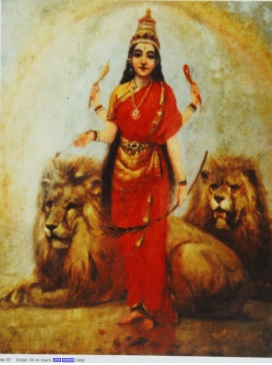 Bharat Mata painting by Raja Ravi Varma 1898 (Image Source: Goddess and the Nation)
Bharat Mata painting by Raja Ravi Varma 1898 (Image Source: Goddess and the Nation)
Title: Bharat Mata
Creator: Raja Ravi Varma
Date: 1898
Type: Oil Painting on Canvas
Order Your Portrait Painting from Photo today!
In a subsequent 1935 oelograph print, Ravi Varma Press released another portrayal of Bharat Mata by the artist. Here, the Goddess stands illuminated against a halo of light in a deep red sari, bearing the four attributes of Durga and Britannia—the hook, snare, arrow, and frond of victory. Once again, two African lions lie at her feet, representing the powerful vahana associated with the goddess. The juxtaposition of the lion, a symbol of British imperial might, as a docile creature under the goddess’s feet, indicates Bharat Mata’s superiority over and subjugation of colonial rule. Ravi Varma commonly incorporated global visual iconography into his works, explaining the African origin of the lions. In later and more widely disseminated versions, Bharat Mata was illustrated with multiple arms grasping the symbols of India's struggle for independence, along with the divine weapons granted to fight oppressive darkness.
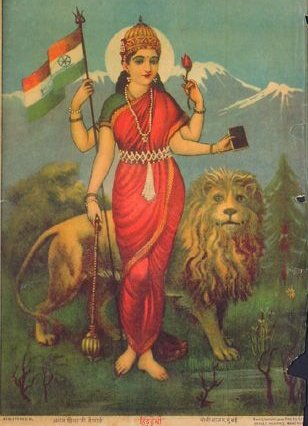 Bharat Mata painting by Raja Ravi Varma Press Oleograph 1935 (Image Source: Goddess and the Nation)
Bharat Mata painting by Raja Ravi Varma Press Oleograph 1935 (Image Source: Goddess and the Nation)
Title: Bharatmata
Creator: Raja Ravi Varma Press
Date: 1935
Type: Oleograph
Born in 1848 to aristocracy in the princely state of Travancore, Ravi Varma was conferred the title of Raja much later in life by the British Viceroy as a personal honor upon receiving the Kaiser-i-Hind medal in 1904.
Ravi Varma gained renown for his oil portraits, paintings of Gods and Goddesses, and historical narrative paintings depicting scenes from Indian mythology and epics like the Ramayana, Mahabharata, and Puranas, which he meticulously reconstructed from textual sources.
Known for the dramatic, theatrical tableaux in his narrative paintings, Ravi Varma conceptualized and idealized female figures using European conventions of gesture and romance, yet adorned in elaborate Indian costuming and placed within contexts like Shakuntala, Draupadi, or Damayanti.
Prior to Ravi Varma, Indian artists were heavily influenced by Persian and Mughal schools of art. While delightful, earlier Indian paintings often appeared compositionally stiff and lacked depth and perspective. Ravi Varma pioneered the synthesis of European naturalism and academic painting techniques with Indian themes and iconography.
Painting of Mother India by Amrita Shergill
Amrita Shergill (1913-1941) is one of the most recognized and iconic artists of Indian modern art.
Her iconic Bharat Mata depicts a poor rural Indian woman with an infant son in her lap and a young daughter by her side, gazing directly at the viewer. By portraying Mother India as an impoverished peasant, Amrita Shergill poignantly commented on the immensity of poverty plaguing India. Painted in oils on canvas, the work marked a radical break from Abanindranath Tagore's idealized wash paintings of Bharat Mata in the Bengal School style. Through the silent melancholy in the mother's eyes, Shergill conveyed a profound sense of pain, helplessness, and hopelessness never expressed in such a raw intense manner before or since.
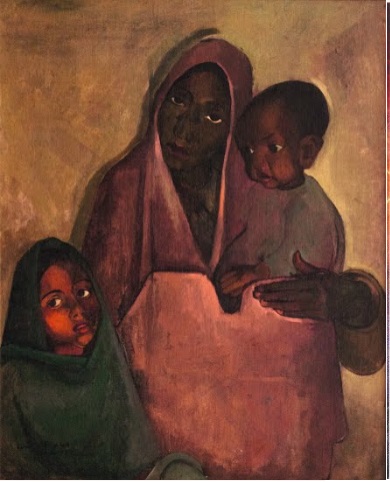 Mother India Amrita Shergill 1935, oil on canvas ( Image Source: Goddess and the Nation)
Mother India Amrita Shergill 1935, oil on canvas ( Image Source: Goddess and the Nation)
Title: Mother India
Creator: Amrita Shergill
Date: 1935
Type: Oil Painting on Canvas
Physical Dimension: 25.5 inches x 32.2 inches (65 cm x 81.8)
Location: Shimla
Order Your Custom Handmade Oil Portrait Painting from Photo today
Amrita Shergill rendered the national personification in her signature avant-garde modernist style, but the tension in her work is quite palpable between avant-garde formalism and the value of emotions - the quintessential modernist dichotomy. Shergill's modernist sensibilities recoiled at the overt pathos evoked in her emotive works, fearing compromise of her artistic integrity. Yet Shergill remained committed to her conviction that "Art must be connected with the soil" and channel "aesthetic emotion" through "significant form."
Born of Hungarian and Indian descent in Budapest, Amrita Shergill spent her childhood in India and Europe. Her aunt Indologist Ervin Baktay first noticed her talent in art. Later Amrita Shergill was formally trained in Arts first at the Académie de la Grande Chaumière under Pierre Vaillent and Lucien Simon and later at the École des Beaux, the same school where one of the finest portrait painters John Singer Sargent also trained some 50 years before.
Her emotionally charged works and her modernist approach prompted the Parisian art critic Denise Proutaux to ask: “Where did this young girl learn to see life with such pitiless eyes and without any illusions? “
As uncompromising as her brushstrokes, Shergill held bold, often controversial opinions about the Indian art establishment. She singled out the Bengal School as the target of her most scathing critiques. In a provocative 1941 radio address mere months before her premature death, Shergill publicly denounced the Bengal School, earning notoriety. As art historian Partha Mitter observes, in his book, The Triumph of Modernism: India's Artists and the Avant-Garde "Her most devastating criticisms were reserved for the Bengal School." Shergill declaratively stated: "Far from fulfilling its vast ambitions, the renaissance in Indian painting led by the Bengal School was responsible for the stagnation of Indian art. Its only raison d’être was to have made at least ‘ a certain layer of people’ in India aware of the great art of the past."
Painting of Bharat Mata by Roop Kishore Kapoor
The revolutionary artist Roop Kishore Kapoor (1893-1978) created bold nationalist works that challenged colonial rule.
Around the late 1920s or early 1930s, Kapoor rendered his take on Bharat Mata. Published in 1931 as a lithograph by Babulal Bhargava Glass and Picture Merchant Cawnpur (now Kanpur), it depicts Bharat Mata arising from a partially visible map of India, including British Burma. Kapoor transforms India into a prosperous, industrious landscape - farmers working the land, boats plying the coasts, a train traversing the east, lofty mansions and temples dotting the terrain. With her body seamlessly merging into the mapped geography, the four-armed Bharat Mata figuratively emerges from the land, towering over the busy vistas.
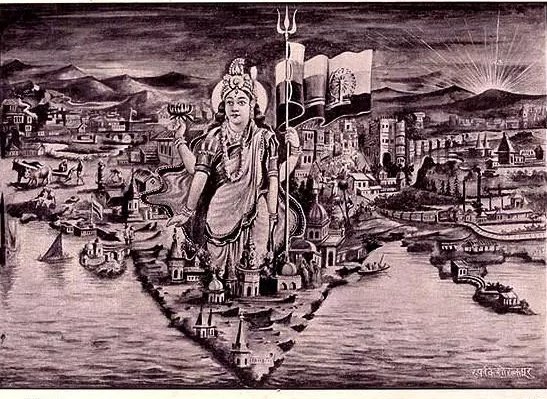 Bharat Mata by Roop Kishor Kapoor 1931 (Image Source: Goddess and the Nation)
Bharat Mata by Roop Kishor Kapoor 1931 (Image Source: Goddess and the Nation)
Title: Bharat Mata
Creator: Roop Kishore Kapoor
Date: 1931
Through this vision, Roop Kishore Kapoor defiantly reimagined Bharat Mata and colonial India as a site of nationalist pride and sovereignty.
Hailing from Kanpur, Uttar Pradesh, Roop Kishore Kapoor produced the provocative image of Bhagat Singh offering his decapitated head to a weeping Bharat Mata. Displaying this work with cries of "Vande Mataram" landed Kapoor in prison.
Based on research in Kanpur, art historian Christopher Pinney reveals that Kapoor was active in the Congress and harbored revolutionary sympathies. Pinney notes more of Kapoor's provocative and prohibited images were held in the India Office Library, than any other artist's work, predominantly on revolutionary subjects reflecting his political leanings and inside knowledge.
Painting of Bharat Mata by ML Sharma
The prolific artist Mohan Lal Sharma (1930-1970) created his own vision of Bharat Mata, capturing the optimism of post-Independence India.
Sharma painted his rendition of Bharat Mata sometime after 1947, possibly the first rendition of Bharat Mata after the independence of India. The youthful, vibrant depiction exudes the confidence, optimism, and hope of the nascent nation. Bharat Mata appears as a young woman in an ornamental bodice, her hair blowing against a background halo suggesting the dawning sun. She boldly rides a chariot pulled by two fierce lions, the newly authorized Indian flag fluttering above within the glowing aura. The entire ensemble sits atop a purple globe outlined with the map of India. Scripted across the map in Devanagari is the Swadeshi movement slogan "Vande Mataram," as if inscribed by an invisible hand.
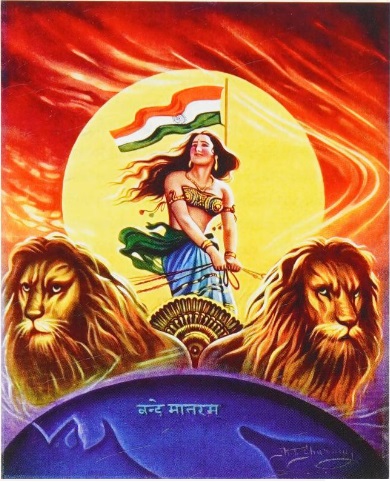 Bharat Mata painting by M.L.Sharma 1947-1952, oil on canvas (Image Source: Goddess and the Nation)
Bharat Mata painting by M.L.Sharma 1947-1952, oil on canvas (Image Source: Goddess and the Nation)
Title: Mother India
Creator: M.L. Sharma
Date: 1947-52
Type: Oil Painting on Canvas
Through his dynamic portrayal of Bharat Mata, Mohan Lal Sharma encapsulated the energy and optimism of an independent India charting its future.
Trained under his father, a religious and portrait painter to Jodhpur royalty, Sharma later studied for eight years with eminent artist A.H. Muller. He obtained credentials including the Maharashtra Government's inter-grade drawing exam, an art diploma from Jaipur's Rajasthan School of Art, and the Royal Drawing Society of London's examination.
Painting of Bharat Mata by Sardar Shobha Singh
The prolific painter Sardar Sobha Singh (1901-1986) created his vision of Bharat Mata which symbolized India's transition to an independent republic.
Likely painted after 1950, Sobha Singh's Bharat Mata depicts the mother figure with a divine halo, wearing a sari draped in a Roman fashion. Her slender arm casually strokes the mane of a fierce lion as it snarls at an overturned British crown, shattering shackles - signaling an end to colonial rule. In the backdrop, the Ashok Stambh ( the Ashokan Pillar), can be seen rising. The new republic's state emblem. A symbol of free India and a bridge to the ancient past of the Mauyrian empire that united India signaling the rising of an ancient civilization..
In many elements of its visualization, the snarling lion, the robe-cum-sari, the overturned crown a clear European influence on the painting is discerned.
The lion, previously associated with Britannia, now flanks Bharat Mata in the tricolor. Its muscular torso and resplendent mane construct a commanding visual persona for Mother India. Through layered symbolism, Sardar Sobha Singh skillfully captured India's transition to a sovereign republic on the world stage.
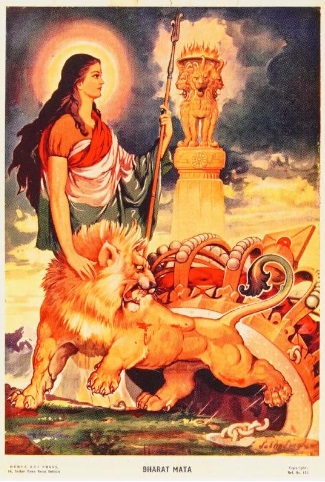 Bharat Mata painting by Sardar Sobha Singh 1950 (Image Source: Goddess and the Nation)
Bharat Mata painting by Sardar Sobha Singh 1950 (Image Source: Goddess and the Nation)
Title: Bharat Mata
Creator: Sardar Sobha Singh
Date: 1950
Born in Punjab, Sobha Singh honed his artistic skills via self-study while working as a British Indian Army draughtsman posted in Iraq. After opening his Amritsar studio in 1923, he produced numerous paintings focused primarily on Sikh Gurus, their lives, and teachings - his devotion manifested in reverent portrayals he hoped would inspire. He also created striking portraits of national heroes.
Bharat Mata by J.B. Dixit
The acclaimed artist and painter Jivaji Bhikaji Dixit (1907-1995) painted an allegorical rendition of Bharat Mata that embodied the nation's spiritual ethos.
Painted in 1975, he rendered his vision of Mother India. Through rich iconography and cartographic form, Dixit infused his Bharat Mata with spiritual potency.
Dixit depicted Bharat Mata as a four-armed Goddess occupying the map of India, with a halo symbolically framing her head in Kashmir. In her upper right hand, she holds a club, denoting strength. Her upper left hand bears a Shankha, or conch shell, representing peace and prosperity. The lower right-hand forms the Abhaya mudra - a reassuring gesture of fearlessness and safety. Finally, she holds a kalash in her lower left hand, evoking abundance, wisdom, and immortality. On her left stands a lion, her vahana an emblem of power. The painting is housed in the Raja Dinkar Kelkar Museum, Pune.
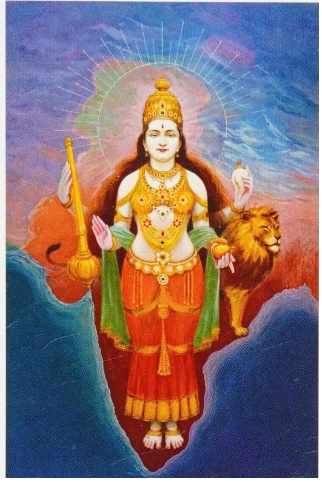 Bharat Mata painting by JB Dixit 1975, oil on canvas (Image Source: Goddess and the Nation)
Bharat Mata painting by JB Dixit 1975, oil on canvas (Image Source: Goddess and the Nation)
Title: Bharat Mata
Creator: J.B. Dixit
Date: 1975
Type: Oil Painting on Canvas
Location: Raja Dinkar Kelkar Museum, Pune, India
Trained at Mumbai's prestigious Sir JJ School of Art alongside luminaries like Gondhalekar and Deuskar, Dixit became renowned for his insightful portraits of saints and religious figures like Dnyaneshwar and Swami Vivekananda.
Painting of Bharat Mata by M.F. Husain
In 2005, a century after Abanindranath Tagore first painted Bharat Mata in his new "wash" style, in 1905, M.F. Husain (1915-2011) rendered his own provocative modernist nude version.
The painting depicts the sun rising over the jagged Himalayas, a svelte woman's torso and limbs whimsically outline India's map. The spokes of the national flag's wheel mark the heartland. Her body was inscribed in English important cities and places: Cochin, Chennai, Bangalore, Goa, Hyderabad, Goa, Kolkata, Mumbai, Jaipur, Varanasi, Delhi, and Srinagar. Two other names appear, Gujarat and Bhopal. The woman is painted in deep red and saffron shades. Over the Bay of Bengal, an outline of a man is shown meditating and on the Arabian Sea, a ship is seen sailing.
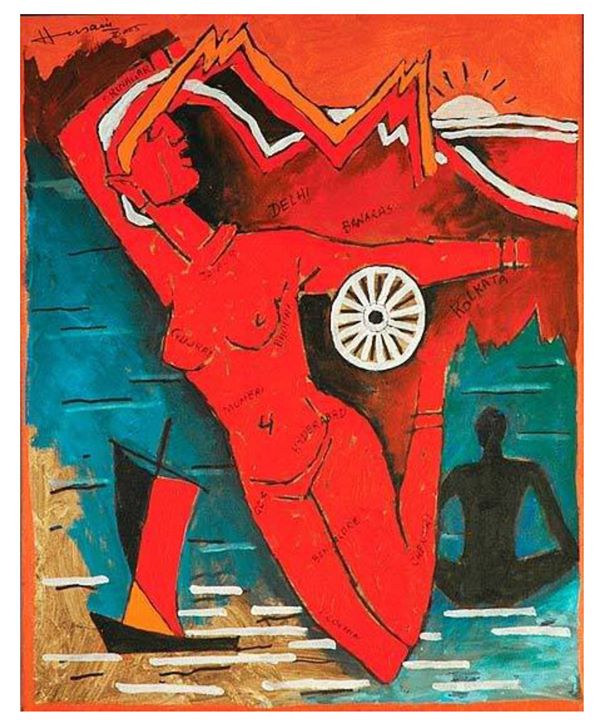 Bharat Mata by M.F Husain 2005, acrylic painting on canvas
Bharat Mata by M.F Husain 2005, acrylic painting on canvas
Title: Untitled
Creator: M.F. Husain
Date: 2005
Type: Oil Painting on Canvas
The painting was Untitled by Husain, but when it made its appearance in an auction in 2006, it was called Bharat Mata. Husain's Bharat Mata created massive controversy among the general public. Earlier in 1996 the controversial artist created outrage with his depiction of Saraswati the Hindu Goddess of learning and knowledge in the nude. In the context of the global disturbances that followed the 2006 Charlie Hebdo incident in France, where radicals threatened the publisher of the magazine Charlie Hedbo for insulting their faith, it was perhaps expected.
The pioneering modernist M.F. Husain (1915-2011) was raised in a working-class family. A self-taught artist his career took off after joining the Bombay Progressive Artists Group in 1947. The group encouraged individualistic modernism unfettered by academic conventions. Although honored nationally and invited to exhibit alongside Picasso in 1971, Husain's irreverent style often stirred great criticism and controversy.
Conclusion
The iconic personification of India as Bharat Mata has been reimagined by artists across the decades to channel the spirit of the times. From Abanindranath Tagore’s graceful Bengal school style to Amrita Shergill’s emotion-laden peasant mother, the visualizations have evolved with India’s self-perception.
Certain motifs persist - the ubiquitous presence of saffron evoking spirituality, the map integrating nationhood, and the lion symbolizing strength and sovereignty. Yet each artist has imprinted their unique vision onto the allegorical mother figure.
As India underwent pivotal milestones from the Swadeshi movement to Independence to becoming a Republic, artists responded by portraying Bharat Mata as increasingly powerful yet always nurturing. This remarkable lineage of paintings demonstrates how creative minds mutually reinforce both art and nationhood.
Moving forward, one wonders how this quintessential national personification will continue to transform. Will she take on a more global or humanitarian avatar? Or retreat into traditional iconography? As long as artists draw on inventiveness and insight to shape their renditions, Bharat Mata will remain a compelling symbol, her visual evolution reflecting the progress of the nation itself.
About Us:
Paintphotographs.com is India's leading custom art platform. We turn your favorite photos, pics, and images into luxurious handmade portrait paintings. Our work includes handmade portraits, custom oil reproductions, charcoal drawings, and sketches. As a team of accomplished artists, we use museum-quality canvas, the best international brands of colors such as Winsor & Newton and Daler Rawney. We work with various mediums, including oil, acrylic, mixed media, graphite, and charcoal.
To order a custom handmade oil portrait painting you can visit our order now page. You can order custom Wedding Paintings, Couple Paintings, Memorial Paintings, Family Paintings, Baby portraits and Children Paintings, Photo to paintings, and Pet Portrait Paintings from Photo.
You can visit our pricing page to know the prices of our portrait paintings. To connect with us ping us on our chat messenger on the website, ping us on WhatsApp, call us at 918291070650, or drop us an email at support@paintphotographs.com
You can visit our gallery pages to see our work. We make photo to paintings, couple paintings, memorial paintings, Kids and Baby Portrait paintings, God & Religious Paintings, Old Photo to Paintings, Wedding couple Paintings & Marriage Portraits, Family Paintings, Pet Portrait Paintings, Radha Krishna Paintings, Oil Portraits of Gurus, Saints & Holy Men, Charcoal and Pencil Sketches, Custom Landscape & Cityscape paintings, Contemporary Art Reproduction & Replica Paintings, Old Master Reproduction & Replica Art, Monochrome and Black & White portrait paintings, Historical Portraits and Shivaji Maharaj Paintings, Celebrity & Political Leaders Portraits. We can also merge separate photos to create a single seamless painting called Composite portraits to add deceased loved ones to make a family oil portrait as though they were present.
Our custom handmade portraits make beautiful Anniversary Gifts, Engagement Gifts, Birthday Gifts, Retirement Gifts, Housewarming Gifts, Mother's Day gifts, and luxurious gifts for many important occasions.
Paintphotographs.com provides bespoke services for art patrons, interior designers, and architects. It helps you create the perfect pieces for residential and commercial projects and serves as a platform for artists to showcase their work.
If you are an art aficionado interested in writing a guest post on art, connect with us.
Want to read more? Check our reading recommendations below! Please refer to the Notes and Reference section for sources referenced in the article.
Like this story? Then you will love our podcasts on Spotify. Listen to our deep dives and fascinating stories from the art world. Join our nearly 20,000-strong community on Facebook, WhatsApp, and X.
Want to see our art? Join our community of 500,000+ subscribers on the Paintphotographs YouTube channel, Instagram, and Pinterest for some amazing art pics & art videos!
Recommended Pieces
Sunayani Devi: The Naive Primitivist Who Pioneered Modern Indian Art | Paintphotographs
The paintings in John Wick Chapter 4 | Paintphotographs
The Ultimate Engagement Gift Guide: Portrait Paintings for Every Couple | Paintphotographs
Oil Portraits and Digital Paintings: What is the difference? | Paintphotographs
India's Greatest Portrait Painters: Lives of 13 Oil Portrait Painting Masters | Paintphotographs
Farewell gifts for Seniors, Colleagues and Friends: Handmade Portraits | Paintphotographs
How to Convert Your Photo into a Canvas Portrait Painting Online - Handmade | Paintphotographs
Bring Your Family Tree to Life: Turn Your Old Photos into Stunning Paintings | Paintphotographs
The life and paintings of artist and painter KCS Paniker | Paintphotographs
What are the different types of portrait painting? | Paintphotographs
Notes and Reference
https://archive.org/details/goddessnation0000suma/mode/2up
The Triumph of Modernism: India’s Artists and the Avant-garde, 1922-47, Mitter
https://www.google.co.in/books/edition/Popular_Indian_Art/mkDrAAAAMAAJ?hl=en
Mother India - Amrita Sher-Gil — Google Arts & Culture
Nationalist Art of Roop Kishore Kapoor
https://web.archive.org/web/20190326075453/http://www.sobhasinghartist.com/life.html
MF Husain's 20-year-old painting of nude deity raises questions about artistic freedom
https://www.google.co.in/books/edition/The_Study_of_Hinduism/npCKSUUQYEIC?hl=en

